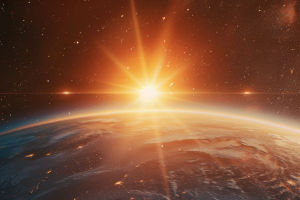When we gaze at the night sky, it’s easy to get lost among the stars—but not everything shining above is a star. Some of those tiny moving lights are satellites, the incredible machines we’ve sent into orbit to serve as Earth’s silent helpers.
Since the launch of the very first one, satellites have transformed the way we live—predicting storms, guiding our travels, and keeping us connected across the planet. They may be far above us, but their influence touches every part of our daily lives.
Weather from Space: Predicting the Unpredictable
We often check weather apps without realizing that every temperature, storm alert, and rainfall map begins with satellite data. Satellites orbit Earth to measure atmospheric temperature, humidity, wind patterns, and cloud formations. These details are transmitted back to meteorologists, allowing them to forecast storms, droughts, or heatwaves with greater accuracy. Thanks to satellites, we can receive early warnings that save lives and help entire communities prepare for severe weather events.
Without these orbital observers, weather prediction would be little more than guesswork. Farmers would struggle to plan planting seasons, airlines would face unpredictable turbulence, and coastal regions might be caught off guard by hurricanes. Satellites make global weather forecasting both reliable and life-saving.
Watching Earth: Our Planet in High Definition
Beyond weather, satellites also serve as vigilant guardians of Earth’s environment. High-resolution images allow scientists to track deforestation, glacier melting, and even ocean temperature changes in real time. We can observe how forests recover after wildfires, how urban areas expand, or how sea levels shift over time.
Environmental satellites also detect air and water pollution, providing crucial data to guide global conservation efforts. For example, when volcanic eruptions or oil spills occur, satellites can quickly assess the affected regions. They help decision-makers act faster and smarter, minimizing damage and supporting ecological recovery.
Finding Our Way: The Power of GPS
We use navigation apps almost every day—whether driving to work, hiking in remote areas, or tracking a delivery. Behind all this convenience lies a network of satellites known as the Global Positioning System (GPS). These satellites constantly send signals to receivers on the ground, helping us pinpoint our exact location within meters.
But GPS isn’t just for travel. It supports air traffic control, ocean shipping, and even rescue operations. When emergencies strike in remote places—such as mountains or deserts—GPS helps teams locate and reach those in need quickly. It’s amazing how a system we take for granted every day depends entirely on satellites orbiting thousands of kilometers above us.
Connecting the World: Communication Without Borders
Imagine trying to watch live news or call a friend across the ocean without satellites—it would be nearly impossible. Communication satellites act like giant mirrors in space, reflecting signals for television, phone calls, and internet access. They allow us to share information instantly, whether through global broadcasts, video meetings, or emergency alerts.
In regions where building internet infrastructure is difficult—such as deserts, islands, or mountain areas—satellite connections bring the world closer together. Every message, video, and photo we send through the web may pass through one of these silent space helpers before reaching its destination.
Expanding Horizons: The Future of Satellite Technology
As technology evolves, satellites are becoming smaller, smarter, and more efficient. New satellite constellations are being designed to improve internet coverage, monitor climate change in greater detail, and even track wildlife migrations. Future satellites may play a key role in solving some of humanity’s biggest challenges—such as disaster response, sustainable farming, and global connectivity.
By continuing to innovate, we ensure that these orbiting instruments remain powerful allies for both science and society.
Beyond the Sky
Lykkers, as we go about our daily routines—checking the forecast, finding directions, or sending messages across continents—it’s easy to forget the silent helpers above us. Satellites work tirelessly, orbiting far beyond the clouds, keeping our world connected and informed.
Just think—without them, our skies would still sparkle, but our world would feel a lot smaller. Navigation, communication, and global awareness all depend on those distant machines. So, next time you look up, remember: beyond the sky, there’s a whole network of satellites watching over us, shaping a smarter and more connected future for everyone on Earth.


